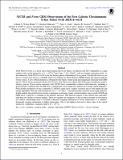NICER and Fermi GBM Observations of the First Galactic Ultraluminous X-Ray Pulsar Swift J0243.6+6124
Author(s)
Wilson-Hodge, Colleen A.; Malacaria, Christian; Jenke, Peter A.; Jaisawal, Gaurava K.; Kerr, Matthew; Wolff, Michael T.; Arzoumanian, Zaven; Doty, John P.; Gendreau, Keith C.; Guillot, Sebastien; Ho, Wynn C. G.; LaMarr, Beverly; Markwardt, Craig B.; Özel, Feryal; Ray, Paul S.; Ramos-Lerate, Mercedes; Strohmayer, Tod E.; Vezie, Michael L.; Wood, Kent S.; Chakrabarty, Deepto; Prigozhin, Gregory; Remillard, Ronald A; ... Show more Show less
DownloadWilson-Hodge_2018_ApJ_863_9.pdf (3.608Mb)
PUBLISHER_POLICY
Publisher Policy
Article is made available in accordance with the publisher's policy and may be subject to US copyright law. Please refer to the publisher's site for terms of use.
Terms of use
Metadata
Show full item recordAbstract
Swift J0243.6+6124 is a newly discovered Galactic Be/X-ray binary, revealed in late 2017 September in a giant outburst with a peak luminosity of 2 × 10[superscript 39](d/7 kpc)[superscript 2] erg s[superscript -1] (0.1-10 keV), with no formerly reported activity. At this luminosity, Swift J0243.6+6124 is the first known galactic ultraluminous X-ray pulsar. We describe Neutron star Interior Composition Explorer (NICER) and Fermi Gamma-ray Burst Monitor (GBM) timing and spectral analyses for this source. A new orbital ephemeris is obtained for the binary system using spin frequencies measured with GBM and 15-50 keV fluxes measured with the Neil Gehrels Swift Observatory Burst Alert Telescope to model the system's intrinsic spin-up. Power spectra measured with NICER show considerable evolution with luminosity, including a quasi-periodic oscillation near 50 mHz that is omnipresent at low luminosity and has an evolving central frequency. Pulse profiles measured over the combined 0.2-100 keV range show complex evolution that is both luminosity and energy dependent. Near the critical luminosity of L ∼ 10[superscript 38] erg s[superscript -1], the pulse profiles transition from single peaked to double peaked, the pulsed fraction reaches a minimum in all energy bands, and the hardness ratios in both NICER and GBM show a turnover to softening as the intensity increases. This behavior repeats as the outburst rises and fades, indicating two distinct accretion regimes. These two regimes are suggestive of the accretion structure on the neutron star surface transitioning from a Coulomb collisional stopping mechanism at lower luminosities to a radiation-dominated stopping mechanism at higher luminosities. This is the highest observed (to date) value of the critical luminosity, suggesting a magnetic field of B ∼ 10[superscript 13] G.
Date issued
2018-08Department
Massachusetts Institute of Technology. Department of Physics; MIT Kavli Institute for Astrophysics and Space ResearchJournal
The Astrophysical Journal
Publisher
American Astronomical Society/IOP Publishing
Citation
Wilson-Hodge, Colleen A., Christian Malacaria, Peter A. Jenke, Gaurava K. Jaisawal, Matthew Kerr, Michael T. Wolff, Zaven Arzoumanian, et al. “NICER and Fermi GBM Observations of the First Galactic Ultraluminous X-Ray Pulsar Swift J0243.6+6124.” The Astrophysical Journal 863, no. 1 (August 6, 2018): 9. © 2018 The American Astronomical Society
Version: Final published version
ISSN
1538-4357
0004-637X